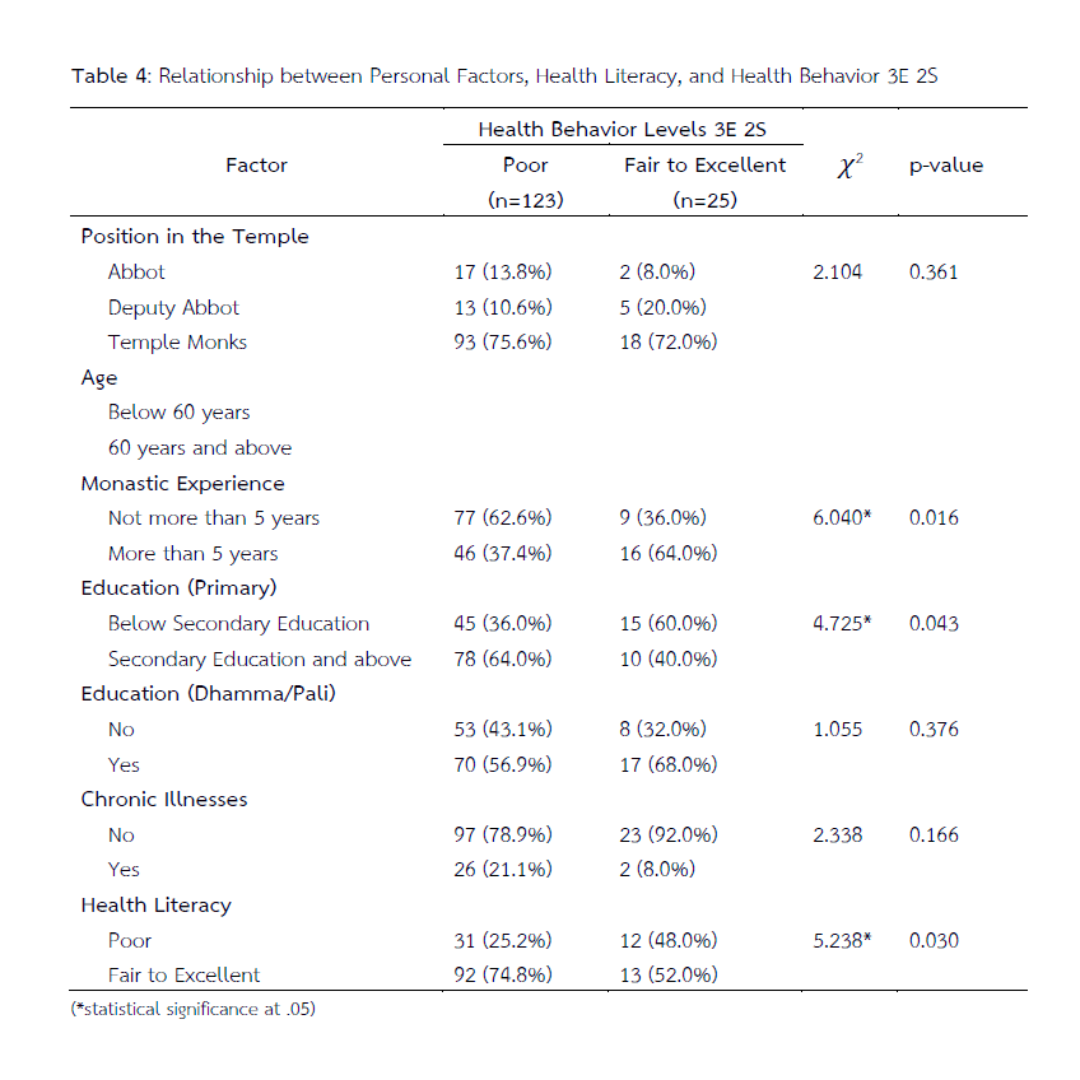ความสัมพันธ์ระหว่างความรอบรู้ด้านสุขภาพกับพฤติกรรมสุขภาพ 3อ. 2ส. ของพระภิกษุสงฆ์ในอำเภอขุนหาญ จังหวัดศรีสะเกษ
คำสำคัญ:
พระสงฆ์, ความรอบรู้ด้านสุขภาพ, พฤติกรรมสุขภาพ 3อ. 2ส.บทคัดย่อ
การวิจัยเชิงพรรณนาภาคตัดขวางนี้ มีวัตถุประสงค์เพื่อศึกษาความสัมพันธ์ระหว่างความรอบรู้ด้านสุขภาพกับพฤติกรรมสุขภาพ 3อ. 2ส. ของพระสงฆ์ในอำเภอขุนหาญ จังหวัดศรีสะเกษ กลุ่มตัวอย่าง คือ พระสงฆ์ จำนวน 148 รูป เก็บข้อมูลโดยการสุ่มอย่างง่าย ระหว่างเดือนเมษายน ถึง มิถุนายน พ.ศ. 2566 เครื่องมือที่ใช้เก็บข้อมูล คือ แบบสอบถาม วิเคราะห์ข้อมูลด้วยสถิติพรรณนา ได้แก่ การแจกแจงความถี่ ร้อยละ ค่าเฉลี่ย ส่วนเบี่ยงเบนมาตรฐาน ค่าสูงสุดและค่าต่ำสุด และวิเคราะห์ความสัมพันธ์ ด้วยสถิติการทดสอบไคสแควร์ ผลการวิจัยพบว่า กลุ่มตัวอย่างส่วนใหญ่เป็นพระลูกวัด ร้อยละ 75.0 อายุเฉลี่ย 48.8 ปี (SD = 17.27) อายุพรรษาเฉลี่ย 7.8 พรรษา (SD = 9.21) ระดับการศึกษาแผนกสามัญสูงสุดประถมศึกษา ร้อยละ 24.3 ส่วนใหญ่ไม่ได้ศึกษาแผนกธรรมหรือบาลี ร้อยละ 41.2 และไม่มีโรคประจำตัว ร้อยละ 81.1 ความรอบรู้ด้านสุขภาพส่วนใหญ่อยู่ในระดับเพียงพอ ร้อยละ 61.5 และพฤติกรรมสุขภาพตามหลัก 3อ. 2ส. ส่วนใหญ่อยู่ในระดับไม่ดี ร้อยละ 83.1 และความสัมพันธ์ระหว่างความรอบรู้ด้านสุขภาพกับพฤติกรรมสุขภาพตามหลัก 3อ. 2ส. มีความสัมพันธ์กันอย่างมีนัยสำคัญทางสถิติที่ระดับ .05 ดังนั้น ควรมีการจัดกิจกรรมพัฒนาความรอบรู้ด้านสุขภาพแก่พระสงฆ์ เพื่อปรับเปลี่ยนพฤติกรรมสุขภาพที่เหมาะสมต่อไป
เอกสารอ้างอิง
Bloom, B.S. (1968). Learning for Mastery. Instruction and Curriculum. Regional Education Laboratory for the Carolinas and Virginia, Topical Papers and Reprints, Number 1. Evaluation Comment, 1(2), 1-12.
Cohen, J. (1977). Statistical power for the behavioral sciences (2nd ed). New York: Academic Press.
Department of Health Service Support. (2017, December 14). Tools and programs for evaluating HL and HB in working age groups. Health Education Division. Research Institute. http://www.hed.go.th/linkHed/333
Hongchai V. et al. (2021). Health literacy and factors predicting health promotion behaviors among Buddhist monks in Nakhon Phanom Province. Journal of Social Science and Buddhistic Anthropology, 6(11), 529-543.
Intarakamhang U., (2017). Creating and Developing of Thailand Health Literacy Scales (research report). Bangkok: Behavioral Science Research Institute.
Jirawutthipan T. et al. (2022). Health Literacy and Self-Management Among Older Monks with Multimorbidity. Nursing Journal CMU, 49(3), 42-55.
Khun Han Hospital. (2023). Khun Han Take care of Thai monks and stay away from disease 4.0 under the drive of the National Monks Health Statute Project. “Monk Thai Klai Rok 4.0” among Khun Han District, Khun Han Hospital, fiscal year 2023. Sisaket: Primary and Holistic Services Group Khunhan Hospital.
Lemeshow S. et al. (1990). Adequacy of sample size in health studies. New York: World Health Organization.
Narathosawadikun J. & Khemkaew P. (2020). Study of factors related to Health promotional behavior of monks in Phichit province. Phichit Public Health Research and Academic Journal. 1(1), 10-23.
National Health Commission Office. (2017). The National Sangha Health Charter B.E. 2560. Nonthaburi: O.S. Printing House.
Nimtrakul U. & Thitawisittho P. (2020). Health Behaviors of Monks and Health Literacy from Phra Kilanuphatthak to Communicators in Health Region 1. Journal of Buddhist Studies, 11(1), 33-51.
Nutbeam, D. (2008). The evolving concept of health literacy. Social Science and Medicine, 67(12), 2072-2078. https://doi. org/10.1016/j.socscimed.2008.09.050
Phanthali, P. (2021). Health care of Thai monks at present. The New Viridian Journal of Arts, Humanities and Social Sciences, 1(3), 14-27.
Phrakrusirisothonkanarak. (2022). The Role of Monks in Promoting Quality of Life. Journal of Buddhist Philosophy Evolved, 6(2), 624-635.
Sookpool A. et al. (2020). Effectiveness of Health Literacy and Health Behavior Development Program for Working People. Journal of Health Science, 29(3), 419-429.
Srithong K. et al. (2021). Health Literacy Situation of Monks in Thai Society. Journal of MCU Peace Studies. 9(5), 1793-1804.
Thirabhatto, P. (2022). The Role of Monks: Amid The Crisis of Thai Society. Journal of MCU Social Science Review, 11(6), A151-A166.
Tongterm, T. (2019). Factors associated with physical activity among the elderly Buddhist monks living in Sisaket province. Journal of MCU Nakhondhat, 6(9), 4425-4437.
Tshopanja A. et al. (2022). Health Literacy and Health Behaviors (Food, Emotion, Exercise, Smoking, Alcohol Cessation and Teeth) of Monks and Novices in Phrapariyattidhamma School, Nakhon Khon Kaen Metropolitan, Khon Kaen Province. Journal of Council of Community Public Health, 4(1), 38-48.
World Health Organization. (1998, June 16). Health promotion glossary. WHO. Research Institute. https://www.who.int/publications/i/item/WHO-HPR-HEP-98.1

ดาวน์โหลด
เผยแพร่แล้ว
วิธีการอ้างอิง
ฉบับ
บท
การอนุญาต
ลิขสิทธิ์ (c) 2024 วารสารสาธารณสุขมูลฐาน (ภาคตะวันออกเฉียงเหนือ)

This work is licensed under a Creative Commons Attribution-NonCommercial-NoDerivatives 4.0 International License.



